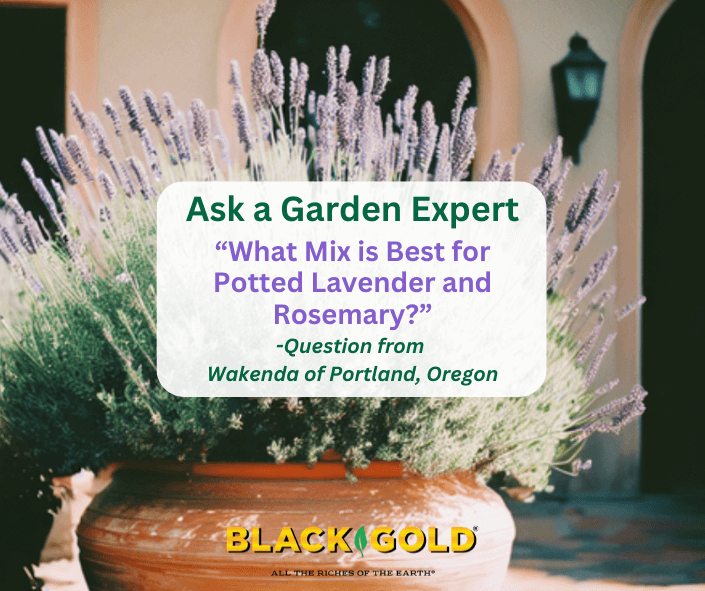
“What is the best soil mixture for potted rosemary and lavender?” Wakenda of Portland, Oregon.


Long ago, Coleus had been considered a house plant. I can remember, my grandmother always had coleus growing in her house. It was a popular winter houseplant because the colorful leaves provided bright spots of color during the long Midwest winter months. Only occasionally were plants planted outdoors during the summer. My, how the times have changed!
Today, coleus varieties have been developed to be sun tolerant and the leaf colors, shapes, and plant habits are widely diverse. While coleus is technically a tender perennial down south, for most of us they are grown as summer annuals and provide wonderful leaf color throughout the season. The plants need warm weather to thrive and cannot withstand frost, but from late spring until the first frost of fall, they look lovely.

When selecting garden coleus, a good rule is to set them out at the same time tomatoes are planted. Both coleus and tomatoes need warm weather, and cold weather can stunt or kill plants if set out too early. Even though some new coleus selections have been developed as sun-loving coleus, I have found most perform better in my garden with some afternoon shade.
Coleus are ideal in both the garden and containers. More compact varieties make superb container plants with their colorful foliage throughout the summer season, such as the new compact, red, purple, and green Coleus ‘Spitfire’. Another I have grown both in a container and the garden is Proven Winner’s showy, ColorBlaze® El Brighto, with its brilliant fringed leaves of red, purple, and gold. (Click here to admire more of Proven Winner’s Colorblaze Coleus.)
Whatever coleus I choose, my potting mix of choice is Black Gold Natural & Organic Potting Mix. It holds moisture well and also provides for good drainage. I add an organic fertilizer at the time of planting and mix it well into the potting mix.
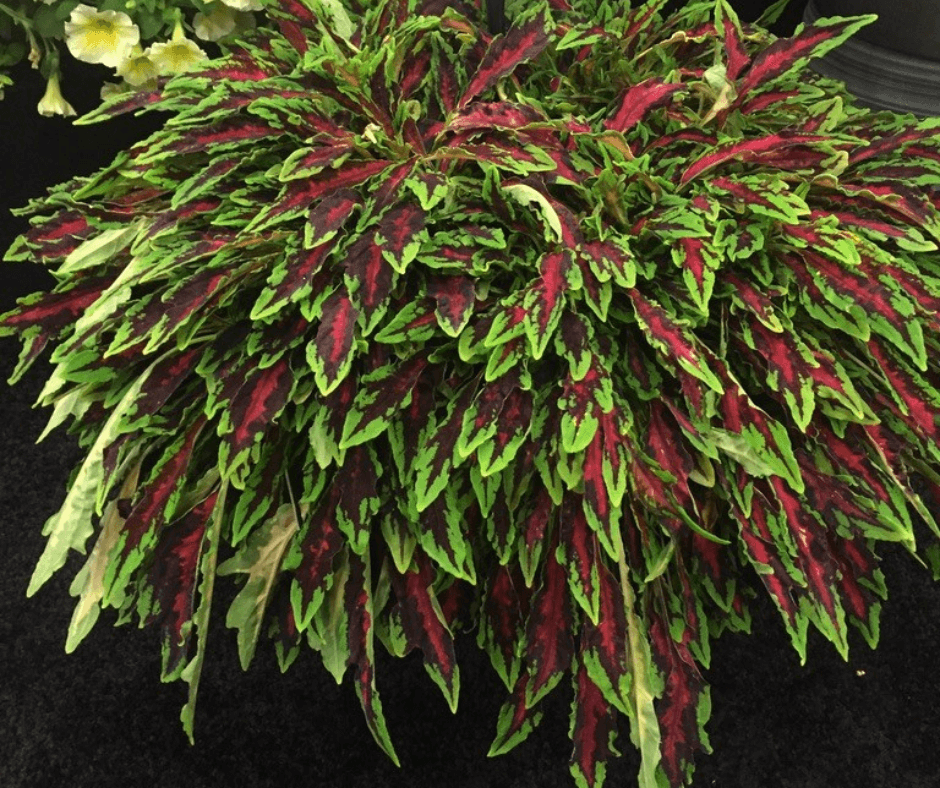
When setting out and growing coleus plants, it is a good idea to pinch the tips of the stems often to encourage a compact growth habit and encourage branching. Sometimes plants will send up spikes of white or lavender flowers. Even though bees like them, coleus foliage looks best if you pinch off the buds before they bloom. Pinching will stop flowering and encourage the plant to produce new colorful growth rather than flowers and seeds.
Sometimes one color plant can create a nice ‘pop’ of color. Last year I planted Coleus ‘Campfire’ with its amber-orange foliage, and it stood out nicely against a background of green (image below). Another bold coleus with only one color is Proven Winner’s Lime Time, which provides a beautiful display of chartreuse leaf color and is especially nice in a shady area. It mixes well with ferns in a woodland setting,

Last summer, I saw a pot of Coleus Spitfire in a garden and was impressed. The variety has a unique layering growth habit as well as brightly colored leaves. It looked beautiful in the container and would work equally well in a hanging basket or a garden edge.
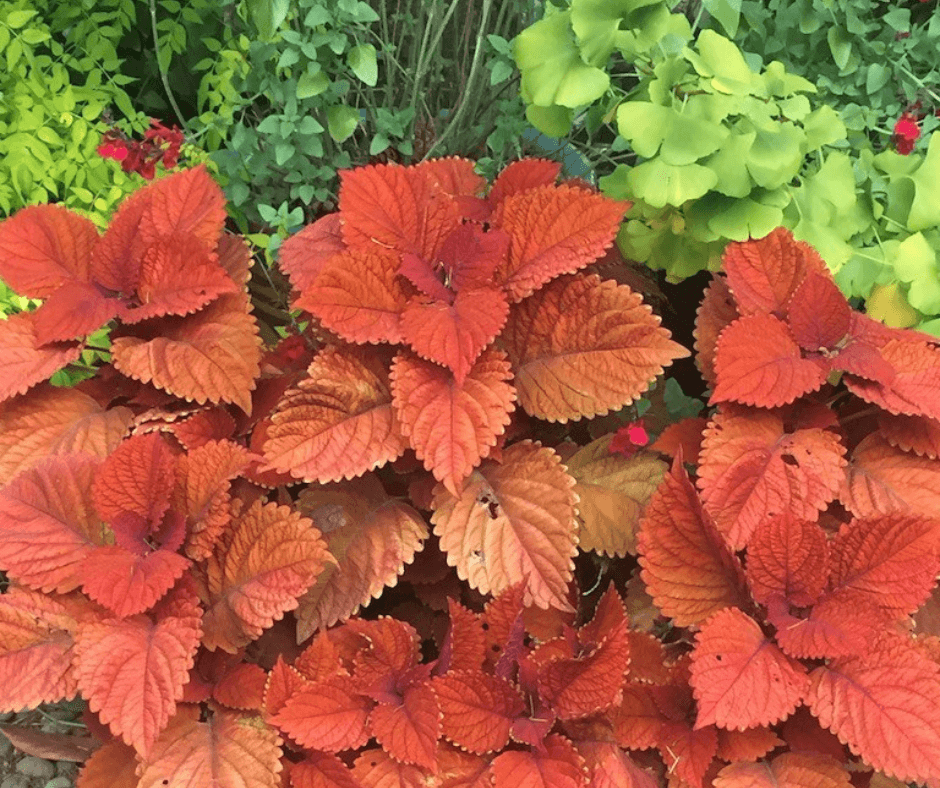
As the summer season ends consider overwintering a coleus. You can either take a cutting to pot up or transplant the larger specimen. They root easily in water and once rooted, can be planted in a small pot and kept by a window for necessary light. (Click here for video details on how to take cuttings.) The plants will probably have to be pinched often as they reach for light, but they are easy to keep over and then planted outside in the spring.
The selection of color combinations is vast and every year there are new forms on the market. Some dwarf types have small leaves and only grow up to about 12 inches. Then there is the Kong series with leaves reaching up to 8 inches in length! If you have not checked out the coleus section at your local garden center, you will be surprised at the diversity of leaf colors and shapes that are available.
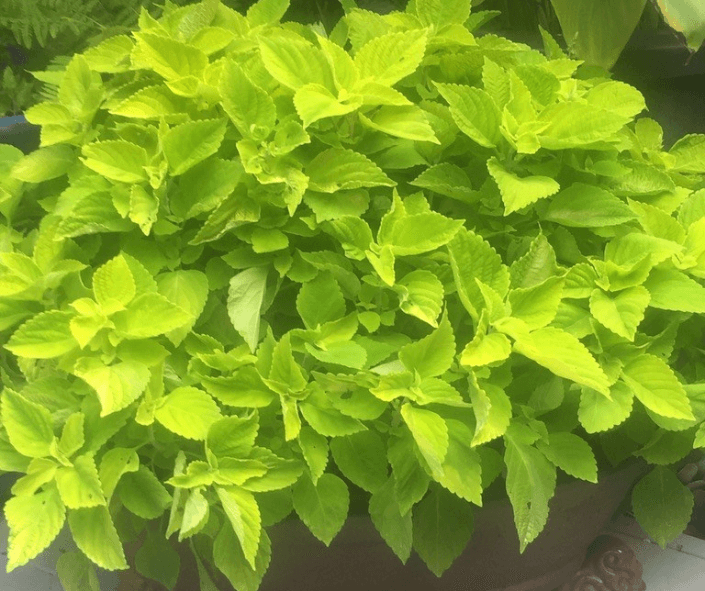
“I am starting a container garden for onions, potatoes, and carrots. I will be using the Black Gold potting mix plus fertilizer. Will I have to add any other product to the potting mix? Thank you.” Dennis of Thaxton, Virginia
Dear Dennis,
Potted vegetables grow best in large containers filled with excellent potting soil, like our Black Gold mixes, and quality fertilizer formulated for vegetables. Be sure that the containers drain well, and keep them evenly moist. Full sun exposure is a requirement. This is about all that you need. Thin your carrot as they grow, and space your onions and potatoes well. I also recommend that you read these articles about growing edibles in containers. We have many, many more on the site.
Happy gardening,
Jessie
“I will be planting shrubs in containers. Which potting mix between Fafard and Black Gold would be the best choice and longest lasting? I would prefer something more permanent so as to not have to change out the potting mix every few years. I live in zone 7. Thank you for your response.” Question from Mel of Atlanta, Georgia
Answer: When recommending the best soil for potted shrubs that will be there for the long term, I always suggest filling the pots with 1/3 quality topsoil or ground soil and 2/3 quality potting mix. Mix the two evenly before filling the pots. I like to add ground soil because potting mixes tend to acidify over time, and ground soil, which is primarily inorganic, helps buffer the acidification process, and it will not break down and shrink over time. You might also consider adding some other ingredients, such as sand or pebble, depending on the shrubs grown. Finally, be sure to refresh the pot with new potting mix seasonally. The addition of dolomitic lime can also reduce acidification.
With that said, I would choose the following mixes for long-term potted shrubs.
Feed your shrubs seasonally in the spring with a slow-release fertilizer. It is also important to note that potted shrubs are most apt to survive winter if they are at least two zones hardier than your zone because they are more exposed.
All the best,
Jessie Keith
Black Gold Horticulturist

“Can watermelon vines be grown in containers?” Question from George of Hagerstown, MD
Answer: Watermelons can be grown in large containers if you choose a compact variety. Here are my recommendations regarding potted watermelon culture.
First, choose a more compact, short-vine watermelon variety suited for container growing. ‘Cal Sweet Bush‘, a 2019 AAS award winner, has excellent melons and vines that do not take over, and ‘Bush Sugar Baby‘ is another small-vined type with tasty melons. Next, choose a large container that’s between 18 to 24 inches. There must be holes at the bottom for drainage. Plastic or glazed containers hold water better in the heat of summer. Fill the pot with quality, porous potting soil that holds water well. I would choose Black Gold Natural & Organic Raised Bed & Potting Mix. Place the pot in a spot where it gets full sun, and the vining stems can hang down and spread a little. Patios or open garden areas work well for large potted vegetables like this.
Plant one or two watermelons in the pot in spring after the threat of frost has passed. Keep the soil moist. When the vines have reached a good size in summer, water daily in the absence of rain. Fertilizer well from the beginning. A good slow-release fertilizer formulated for vegetables is ideal. Be sure to follow the manufacturer’s application instructions.
Melons should start to appear by late July or August.
Happy melon growing!
Jessie Keith
Black Gold Horticulturist
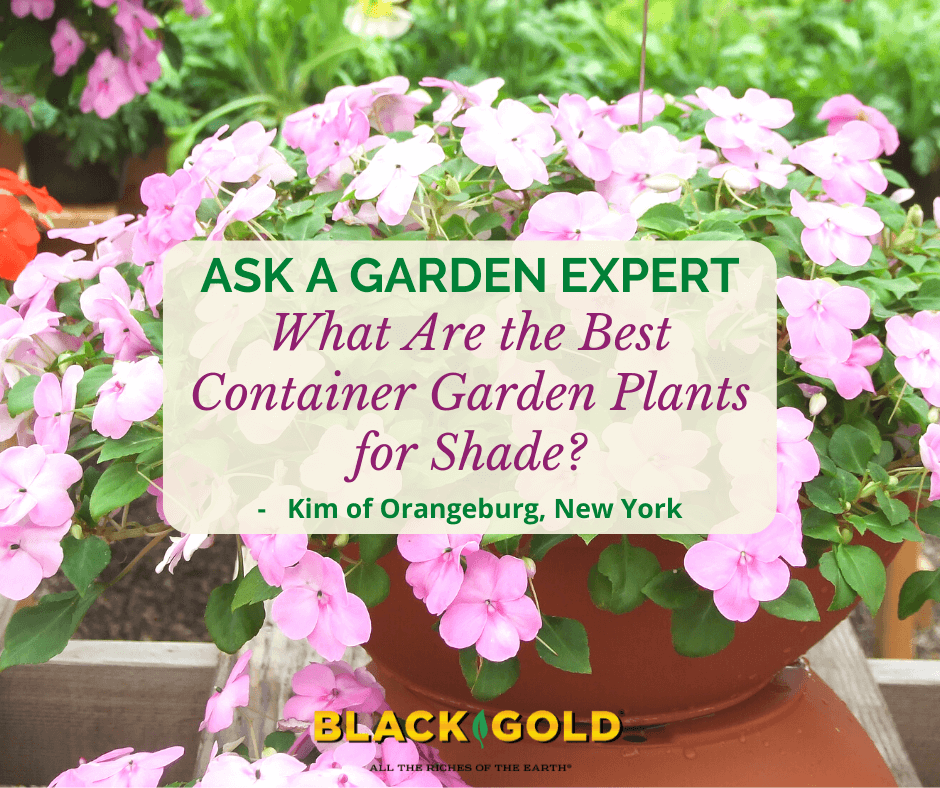
“I’m in a complex where we can only plant in containers outside…and there’s a lot of shade to complicate matters…any idea for some plants that would do well contained without a lot of sun? Thank you…also someone told me the ivy I did plant in a pot can be brought inside for a houseplant when it gets too cold outside true or not?” Question from Kim of Orangeburg, New York
Answer: There are lots and lots of wonderful annuals that thrive in shady locations. The perennial vine, English Ivy (Hedera helix), can grow in pots inside or out, and it will take shade, but there are many better options for shade containers. Here are some of my favorite shade-loving annual garden flowers for summer potted gardens.
Begonias: You can’t go wrong with begonias, as long as you provide them with good moisture, especially through the hottest summer days. Two showy high performers are Bossa Nova® Red Begonia and Illumination® Golden Picotee tuberous begonia. Classic wax begonias that you can purchase in flats at every garden center are also inexpensive and excellent.
Bush Violets (Browallia hybrids.): These annuals are nonstop summer flowers. Try the true-blue Endless™ Illumination Bush Violet.
Coleus (Solenostemon hybrids): There are hundreds of different types of coleus available with the most colorful, beautiful foliage imaginable. Click here for a wonderful coleus online nursery! (Click here to learn how to take coleus cuttings to generate new plants for free!)
Classic Impatiens (Impatiens walleriana): Pick up a flat of colorful impatiens at your favorite garden center, and plant them in shady pots for summer-long color. (Impatiens are also easy to start from seed! Click here to learn more.)
New Guinea Impatiens (Impatiens hybrids): These impatiens are generally taller and tolerant of a little more sun than classic impatiens. the tangerine-orange Infinity® Orange is especially pretty as is the crimson-pink and pale pink Infinity® Blushing Crimson.
Torenia (Torenia hybrids): You cannot go wrong with any of the spreading torenia in the Summer Wave Series. They spread and bloom all summer long. Summer Wave® Large Blue is really lovely.
For more ideas, try the Proven Winners Container Garden Recipe search. It is a great resource for gardeners just learning how to create spectacular potted gardens. Just be sure to choose “Full Shade or Part Shade” for the sun-exposure dropdown. I also recommend clicking here to learn more about growing perennials in containers.
Happy gardening!
Jessie Keith
Black Gold Horticulturist
“Hi — I just transplanted tomato starts from the bathtub to larger containers and used Black Gold All Purpose for much of it. I had one bag of All Purpose and one of Natural, Organic. I noticed that the All Purpose has more fertilizer in it. The Natural Organic has less, but it is natural and organic. Still, I’m thinking I should generally use the All Purpose — because it seems like the transplanted tomatoes have really benefited from the fertilizer in it (more than they might benefit from what’s in the Natural/Organic). What’s your perspective? I don’t think it’s my imagination that the tomato starts to look quite a bit better after transplanting into the All Purpose. I’m just not sure if they’ll do roughly equally well in the Natural and Organic Potting Soil. There’s less fertilizer. I don’t see the differences clearly yet with my starts for reasons that I won’t bore you with. Please advise. :-)” Question from Steve of Bow, Washington
Answer: The Black Gold All Purpose Potting Mix contains supplemental fertilizer to feed plants for up to six months, while Black Gold Natural & Organic Potting Soil contains no added fertilizer. That’s why you saw better growth in the seedlings planted in the All Purpose, but both are good choices for potted vegetable growing. I would also add that tomatoes are very heavy feeders, so I recommend adding fertilizer that is specially formulated for tomatoes anyway. There are loads of fertilizer options for tomatoes on the market.
We have several other soils that are ideal for tomato growing because they hold extra water and are OMRI Listed for organic gardening. These are Black Gold® Natural & Organic Flower and Vegetable Soil, which is very porous and fertile, and Black Gold Natural & Organic Ultra Coir, which holds extra water for thirsty tomatoes. From there, I recommend that you watch the video below with great tips for how to successfully grow tomatoes in containers.
Happy tomato growing!
Jessie Keith
Black Gold Horticulturist
“What is the best potting mix for Meyer lemon tree in a plastic pot? Needs to drain well.” Question from Polly of New Mexico
Answer: We offer several good-fit mixes. Before potting your tree, make sure that the new pot is several inches larger than the old and that it offers excellent bottom drainage. The ideal potting soil should have a balance of good porosity, drainage, and water-holding ability. Ideally, it should be slightly acid, because Meyer lemons grow best in soils with a pH of 6-7. Here are our best OMRI Listed soils for your tree.
Potted citrus trees require a minimum of 8 hours of sunlight a day to perform well. Warm growing conditions (60 – 75 degrees F) and moderate humidity (45 – 50%) will encourage flowering and fruiting. Bringing plants outdoors in summer, on a sunny porch or patio, helps them grow better year-round.
Good watering, feeding, and care practices will keep your plant happy. Water plants deeply until the water drains from the bottom of the pot. Allow pots to become moderately dry between watering–the tops should be dry down to a minimum of 3 inches. (Outdoor plants may need to be watered almost daily, while indoor plants require less frequent water.) During the winter months, when growth naturally slows, the watering regime should be reduced. Signs of overwatering include leaf yellowing and drop and eventually stem death. Trees allowed to become too dry may also unexpectedly drop some leaves.
Fertilization is essential, any slow-release fertilizer formulated for citrus would be ideal.
I hope that these tips help!
Jessie Keith
Black Gold Horticulturist

Vegetable gardening is on the rise. Gardeners of all experience levels and backgrounds are growing their own food, whether they live in urban environments or spacious suburbs and countrysides. Those living where space is limited have extra challenges, which means that they must garden differently to produce enough food to enjoy all season. Here are some of the ways that we have used to grow fresh food where space and sunshine are at a premium.
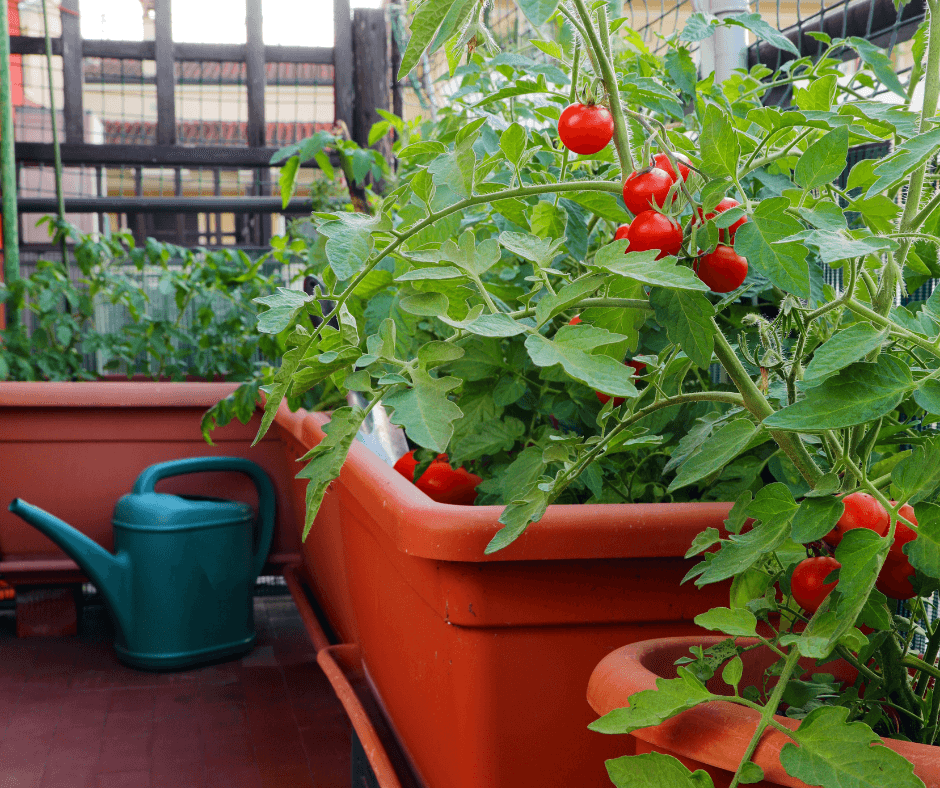
If you have a sunny balcony or patio with just enough space for a couple of pots, choose the largest, deepest pots that will fill the space. Large containers (22 to 24 inches minimum) Let gardeners grow more produce, and they have deeper reservoirs for soil and water to encourage more root growth and reduce the need to water as often. The pots must have good drainage and be filled with a quality mix, such as Black Gold® Natural and Organic Raised Bed & Potting Mix. A couple of large pots, or one long, deep raised pot, will be vastly more productive than several smaller ones, so go big! (Click here for more tips on growing potted vegetables.)
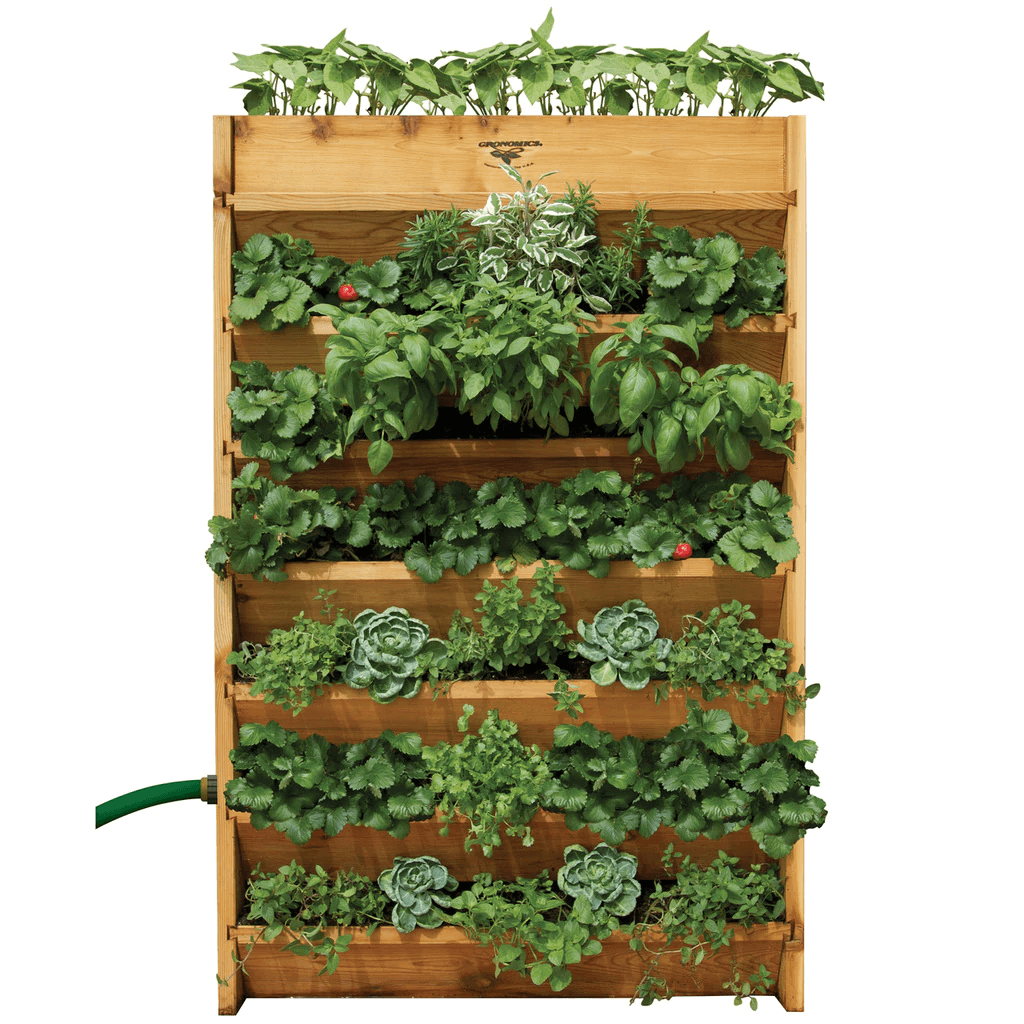
Gardeners with a little more space, like a small, sunny rear patio or yard, should consider growing one or more vertical gardens. Clever vertical planters are being designed to allow lots of vegetables to be grown in a small space. There are also plenty of DIY vertical garden designs to consider if you are the creative type. Whether you choose a premade product or go for a less expensive make-your-own vertical garden, make sure that the design allows for easy irrigation, holds enough soil for plants to grow well, and will last for a long time.
Most upright planting systems are best suited to smaller vegetable crops, like greens, bush peas and beans, baby carrots, beets, bush tomatoes, bush beans, compact peppers, and bush cucumbers and squash. Fruits, such as strawberries and low-bush blueberries, are also good options. (Click here to learn more about growing blueberries. Click here to learn more about growing strawberries.) (Click here to learn more about vertical vegetable gardening.)

Smaller vegetables and fruits are made for container growing, so choose varieties better suited to pot culture. This includes non-vining bush tomatoes, such as ‘Mountain Merit‘ and ‘Celebrity‘, both AAS winners. The tiny, cute cherry tomato Tempting Tomatoes® Patio Sunshine is another excellent choice. These are just a few of the many quality little tomatoes available. Tiny bush basils are fun to grow at the base of potted tomatoes. Windowbox Mini from Renee’s Garden Seeds is a superior little basil that’s very easy to start from seed.
There are plenty of other compact bush vegetables, such as ‘Bush Pickle‘ cucumber, the little butternut ‘Butterbush‘, and compact zucchini ‘Fordhook‘. If you like melons, the compact ‘Minnesota Midget‘ cantaloupe and short-vined watermelon ‘Bush Sugar Baby‘ both grow well sprawling from a large pot. Strawberries of all types are great for pots. The beautiful Berried Treasure® strawberries, with their double pink, red, or white blossoms, also yield delicious sweet berries through summer.
Root vegetables of all kinds grow well in containers. Carrots, turnips, beets, and radishes are among them. Just make sure that the pots are deep enough for good root development. Upright vegetables, such as tomatoes, peppers, and eggplant, should be staked or caged to supply added support. (Click here to learn more about my favorite miniature vegetables.) (Click here to learn about the best fruits for container growing.)

Some vegetables and fruits grow beautifully in large hanging baskets. As with the pots, go big to minimize watering and maximize performance. The best vegetables for hanging are cascaders, such as compact tomatoes, strawberries, dwarf cucumbers, and peppers. The new, compact Pot-a-Peño jalapeño pepper is ideal for hanging baskets. This variety is also a 2021 AAS award winner, so it is sure to perform well.
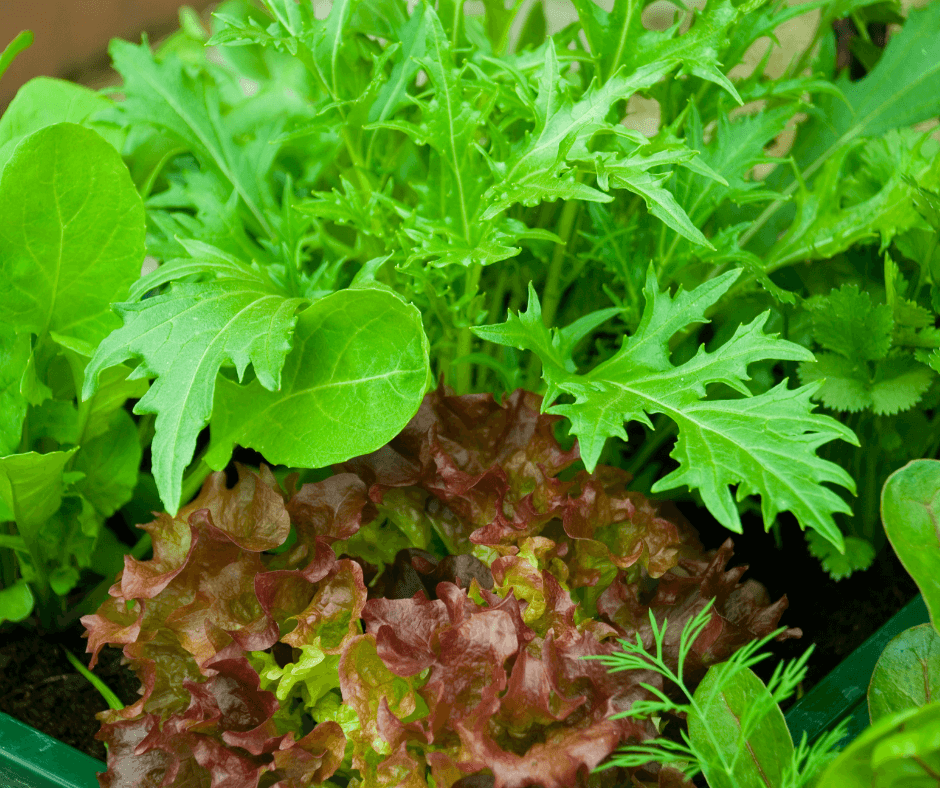
Vegetable gardening is a dynamic process. Gardeners have to shift from cool-season spring vegetables to warm-season summer vegetables back to cool-weather crops. In between, smart gardeners rotate their crops to continue the harvest and encourage garden health. Plan to harvest and plant, harvest and plant until fall to boost your garden’s yields and diversity of crops. Seasonal planting and rotation keep soil diseases and pests from taking hold. (Click here to learn more about rotating vegetables.)
Place containers and gardens where they get maximum sunlight. Eight hours a day or more is recommended. Start with great soil that holds water well, has ample air space, and drains well. Black Gold®Natural & Organic Potting Mix is ideal for growing all types of vegetables in containers and it is OMRI Listed® for organic gardening. It’s wise to add a little Black Gold Earthworm Castings Blend 0.8-0.0-0.0, which is rich in nitrogen, to pots with greens and herbs. Change a pot’s soil every two to three years because peat-based potting mixes break down, lose structure, and acidify over time.
Fertilize regularly to encourage the best growth and production. Lots of vegetables are “heavy feeders”, which means they deplete nutrients from the soil fast. Apply a slow-release fertilizer formulated for vegetable gardening at the start of the season. For heavy feeders, like tomatoes, follow up with applications of a water-soluble fertilizer formulated for vegetables. This is especially important to do just before the fruits develop.
Lack of water is the main cause of container vegetable failure. During the hottest days of summer, daily water will likely be needed, especially if your pots are in the full, hot sun. At watering time, water until its starts to run out of the pot drain holes. This indicates that the container is saturated. Thorough watering encourages deeper root development and stronger, more stable plants.
If your time is limited, consider investing in drip irrigation for pots. It also helps to add an extra layer of porous organic mulch to keep surface water from evaporating. Leaf mulch, straw, or grass clippings are all great options for pots that break down quickly while providing a little extra protection. (Click here to read about the 8 best watering strategies for plants.)
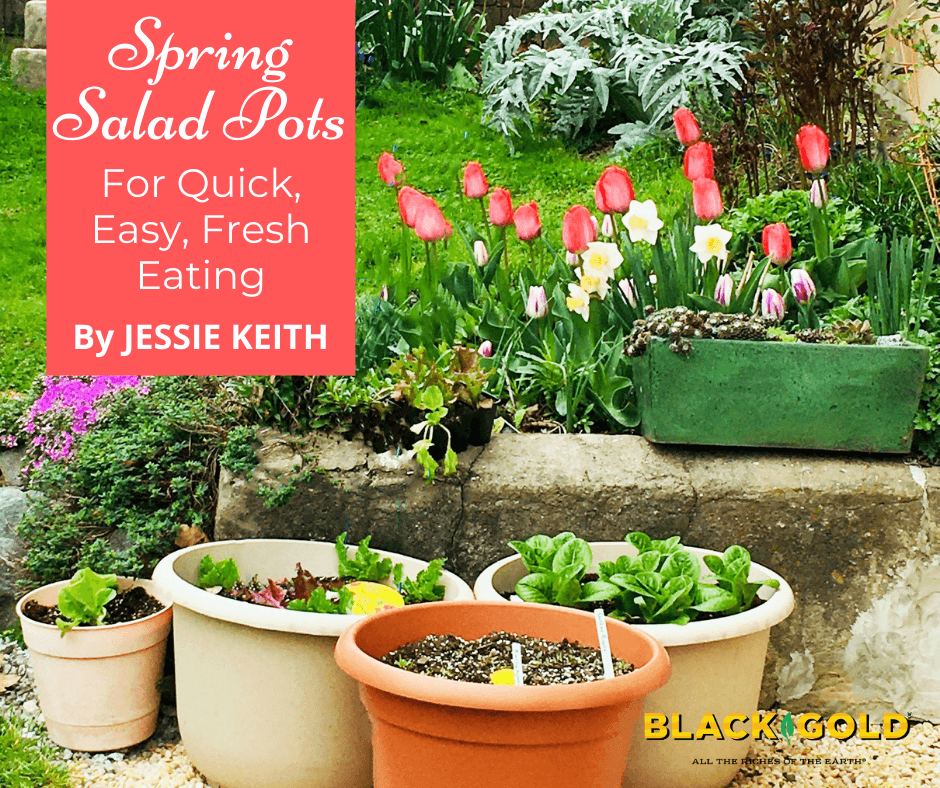
My first spring salad pots were grown in large, inexpensive plastic containers that I bought from the garden center. I filled them with some Black Gold Natural & Organic Potting Mix and added a little fertilizer. They performed so well that I couldn’t believe it. Just a few pots provided delicious salads through spring, so this year I decided to redo this year’s salad containers with a little more flair.
I took it up a notch by creating suites of well-paired greens and herbs for custom-made salad containers–one with an Asian theme, another French, and the last for the Italian palate. Large (18″ or 24″) pots are ideal for these plantings. This will ensure that you can plant enough vegetables in each pot to make several spring salad bowls. As I said, I planted mine in Black Gold Natural & Organic Potting Mix, but this year I plan to try Black Gold Raised Bed & Planting Mix. Both mixes are OMRI Listed for organic gardening. My plant food of choice is a slow-release fertilizer for vegetable growing, though I often hit my plants with some water-soluble fertilizer a week after planting to help them take off.
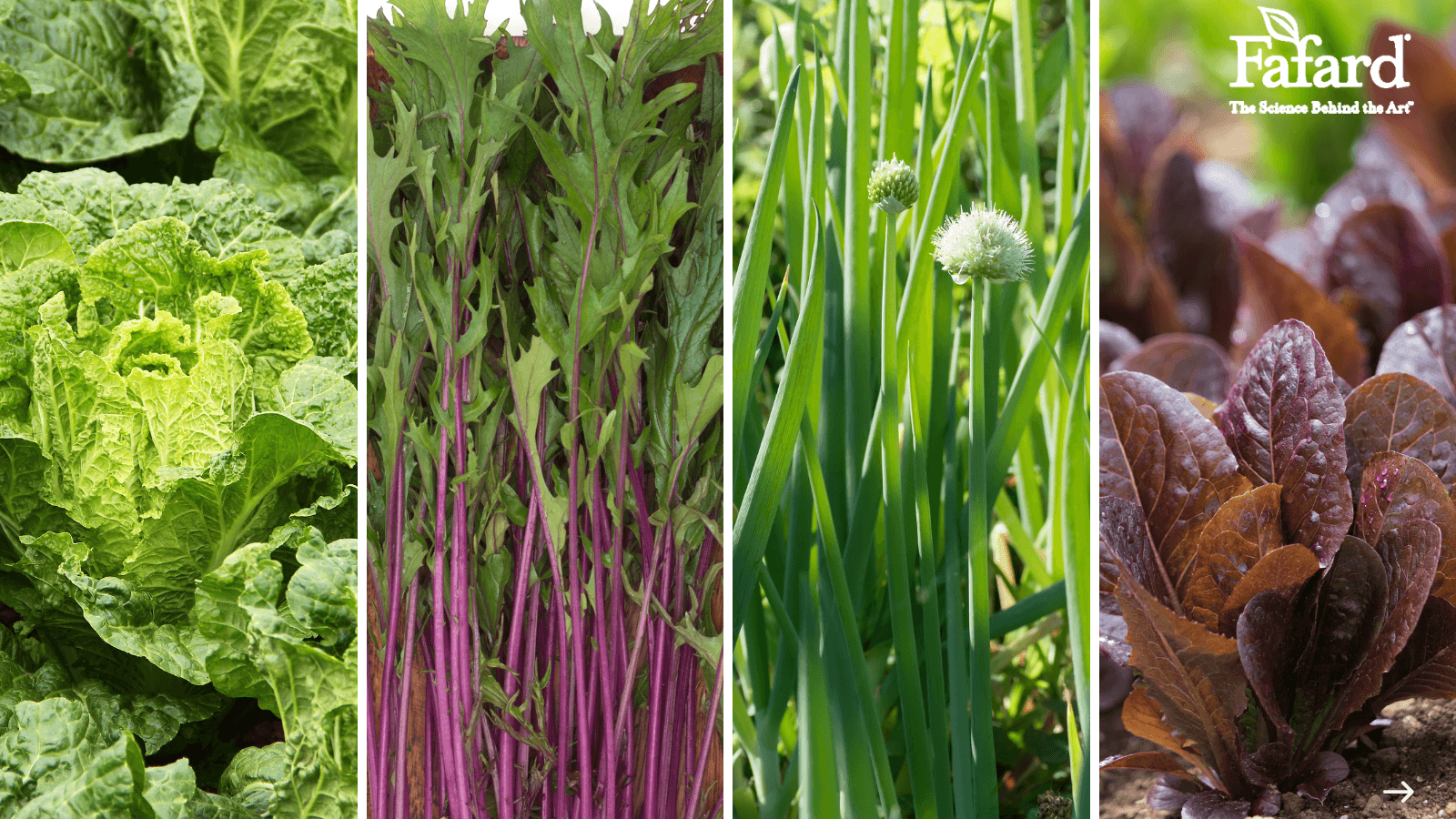
Asian Salad Pot: Spring Crisp Chinese Cabbage (63-65 days), Central Red Mizuna (40-55 days), Ishikura Improved Bunching Scallions (40-50 days), and Red Romaine Lettuce (56-60 days).
About the blend – This is a two-pot salad mix because Chinese cabbages are bulky. I am confident that the outcome will be worthy of a very tasty sesame salad dressing. The crisp, flavorful Chinese cabbage will combine nicely with the mustardy kick of the mizuna, the mild green-onion flavor of the bunching scallions along with the crunchy, sweet taste and bright color of the red romaine.
Planting tips – I recommend filling one pot with three Chinese cabbage heads with a sprinkling of mizuna around the exterior. Another pot can contain the romaine with scallions planted along the side. Be sure to space the scallions 2-3 inches apart. I always start cabbage, scallions, and lettuce plants indoors several weeks before planting outdoors. I start the seeds in 4-inch pots under grow lights. (Click here for growing tips.) Then I acclimate my seedlings to cool spring temperatures in my enclosed back porch. Scallions are often tender and slender at planting time, so be gentle with them and don’t plant their bulbs too deeply. One-half inch is perfect. The mizuna is a mustard green that can directly be sown in the pots at the time when you plant your seedlings–generally in late March or early April in my USDA Hardiness Zone 7 garden.
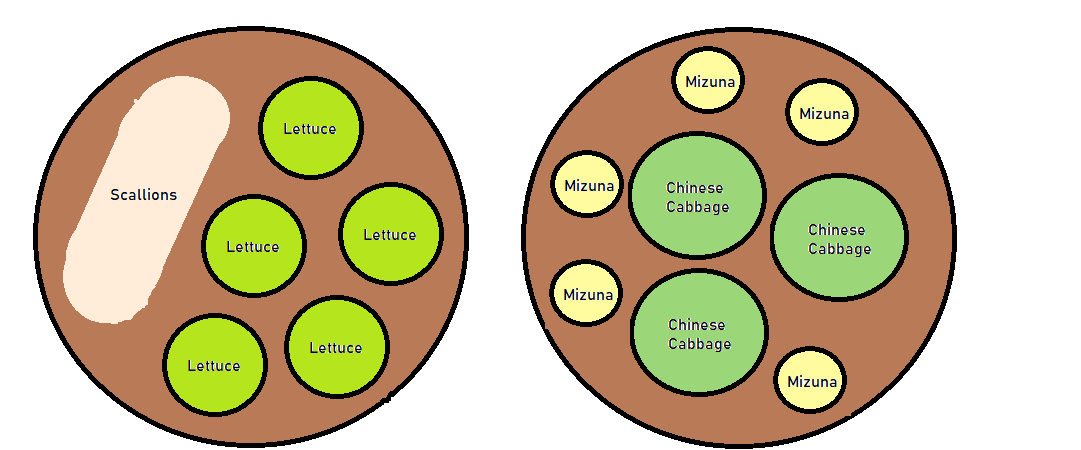
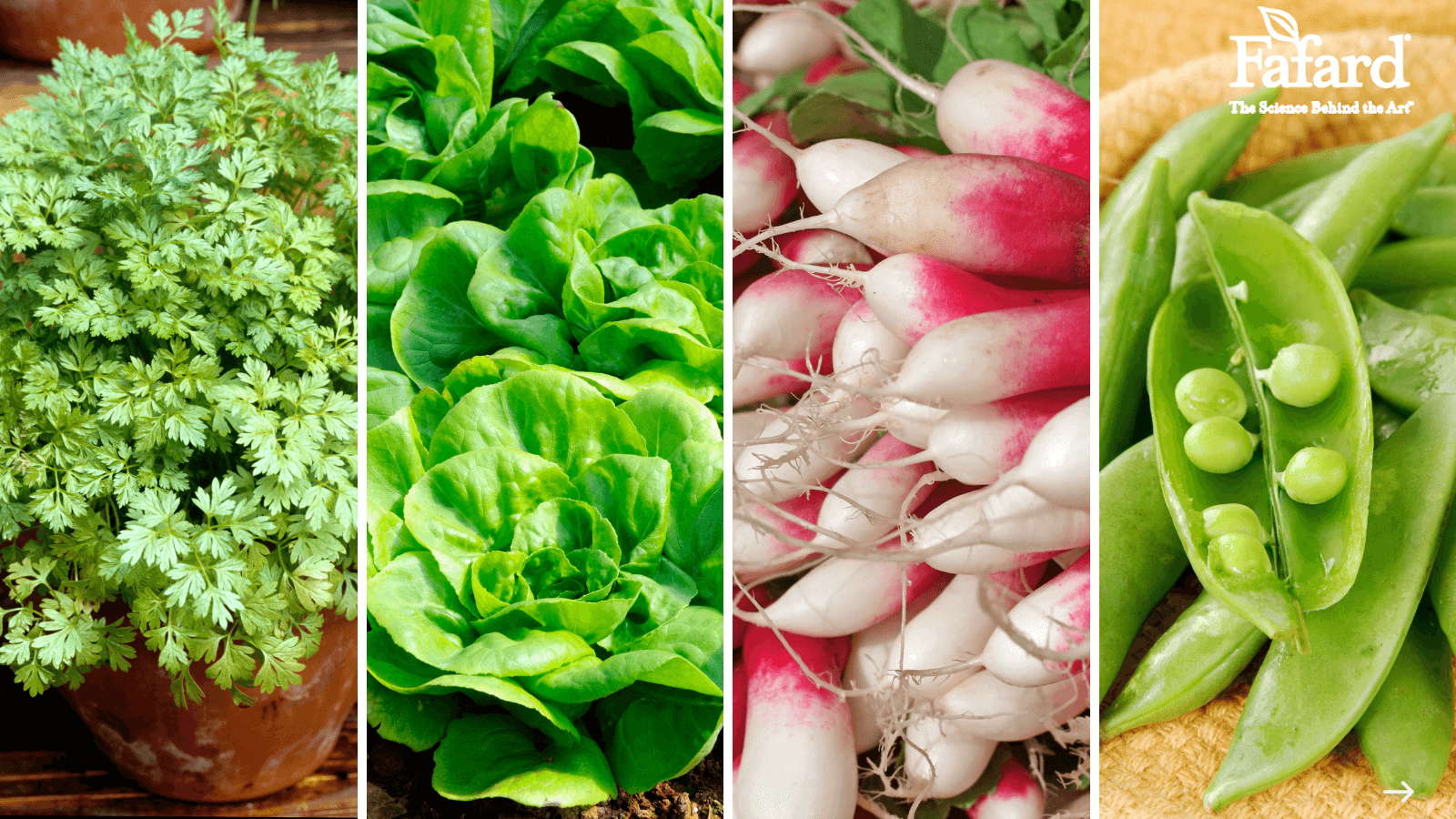
French Salad Pot: Classic Garden Chervil (60 days), Divina Butterhead Lettuce (60 to 70 days), Flamboyant French Breakfast Radish (25-30 days), and Sugar Ann Snap Peas (52-62 days).
About the blend -The sweetness of the snap peas and butter lettuce blend well with the slight heat of the fresh French breakfast radishes. Chervil is added to provide a fresh, slightly anise flavor–much like the flavor of fennel. Together they taste very excellent with a classic French dijon vinegarette. If you are not partial to uncooked snap peas, try blanching them for a minute and then immersing them in an ice-water bath.
Planting tips – I recommend three large pots for this salad blend–one for the peas (a tomato cage makes an easy pea trellis), one for the radishes, and one for the butter lettuce with two chervil plants on the side. It is best to start the chervil and lettuce indoors under grow lights, as recommended for the greens above. The radishes and peas can be directly sown in the pots. Surface-sow the radish seeds and cover them with 1/8 inch of potting mix. Plant them in circular rows 6 inches apart and then thin them to 3 inches apart after they have sprouted. The peas should be planted in a circle at a distance of 3 inches apart and 1 inch below the soil surface. Time everything well, keeping in mind that the peas and greens need more time than the fast-growing radishes.
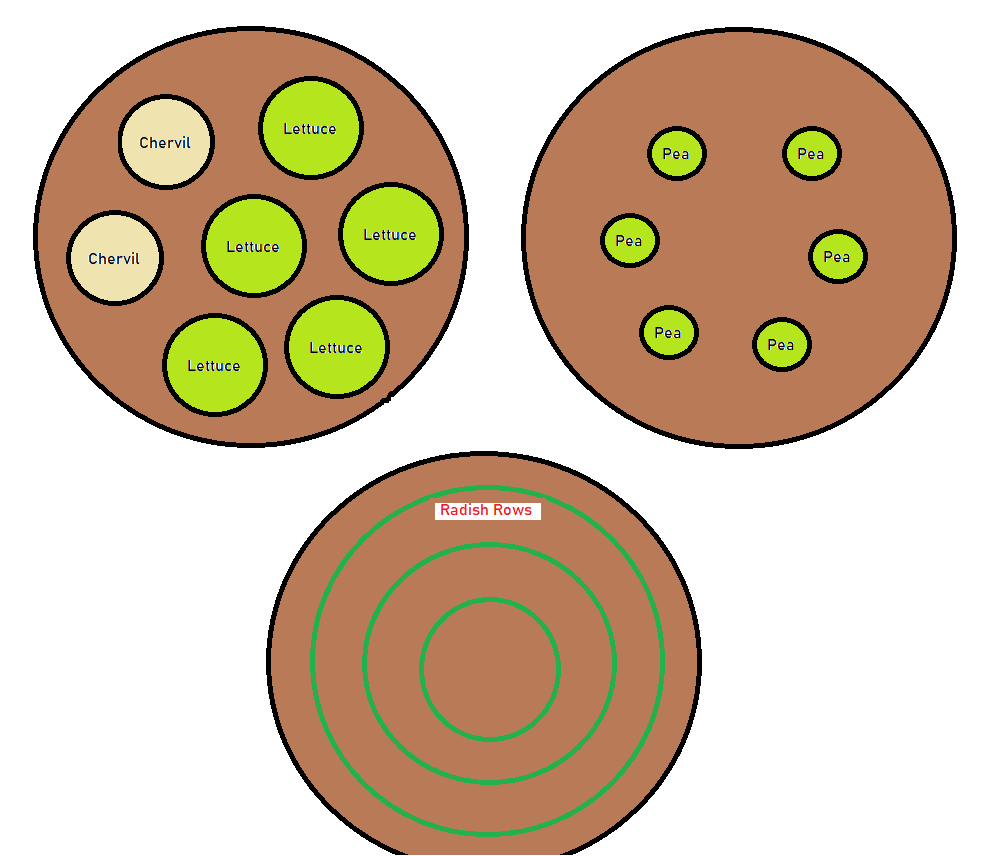
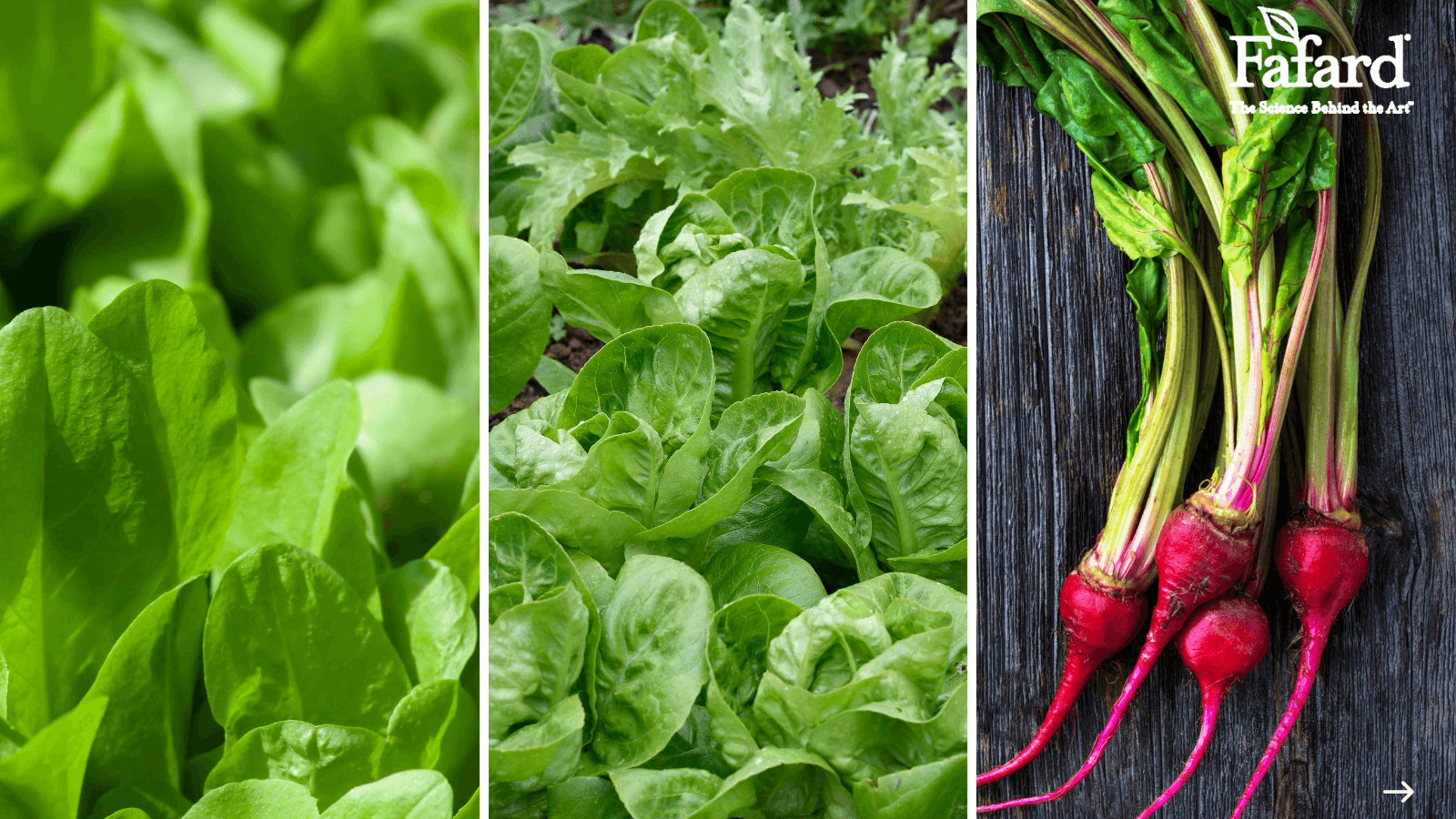
Italian Salad Pot: Chicory Bionda (35-45 days), Romaine Bionda Lettuce (55-60 days), Baby Chioggia Beets (40-55 days).
About the blend – The bitter bite of the chicory tastes nice with the sweet crunch of the romaine lettuce and sweetness of the baby beets. Chioggia beets are candy-striped with red and white bands inside, so they are as beautiful as they are delicious. The three taste very good with honey balsamic vinegarette and shaving of Parmesan cheese.
Planting tips – Two large pots are sufficient for this salad blend–one for the chicory and romaine lettuce, and one for the beets. The lettuce and chicory can be started as seedlings indoors, using the same recommendations for the two previous gardens. The beets should be directly sown in the pots. Keep in mind that the beets may germinate more slowly in cool weather, so you may want to plant them a week earlier than recommended on the packet.

To learn more about great lettuce varieties, please watch this helpful video!